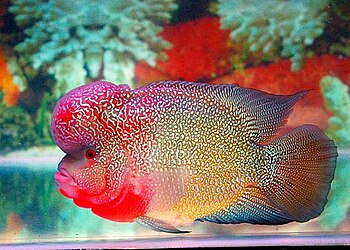 |
| "Peten Itza lake" by R. Villalobos (talk) |
There are different types of hobbyists. Some like freshwater species, some like marine and some like both. Most like “hunting” for prized specimens in their local fish store or may even venture to the city next-door for new hunting grounds. But there is a special kind of hobbyist…
There are some of us who love capturing our own fish. I was lucky enough to live in Guatemala when I discovered the aquarium hobby and immediately started looking for species that where described in some of the books I had. There are about 150 species of freshwater fish in Guatemala.
At the time I lived in the northern part of Guatemala, called Peten. It’s mostly tropical rain forest and the soil is lime based like most of the Yucatan peninsula. There are few large rivers and even finding a creek was not easy but I lived on the shores of the Lake Peten Itza, the largest of the area. This lake has its share of cichlids like the Yellowbelly Cichlid (Cichlasoma salvini), the Jack Dempsey (C. octofasciatum), etc. I also found some species of catfish like Rhamadia guatemalensis, some types of Gars, tetras etc.
Now if you want to go down there and catch some for yourself, what you have to do is go to Flores, this is a small Island and it’s the Capital of the Department of Peten. Once in Flores, find the public docks. Here you will find a number of small wooden boats waiting for passengers. They will offer to take you to the various touristy places normal Americans on holiday visit. Just say no thank you or “No Gracias”. Ask any boatman to direct you to a fisherman or even ask him to take you to the village of San Miguel. This is a tiny little village consisting mostly of fishermen so finding someone fishing will be no problem. They catch small fish for bait with different types of nets. You could bring your net and simply get a boatman to ferry you around, for a fee of course, and cast your own. If this is what you decide to do, find a place that has shallow water with lots of water plants. This is the hunting ground of most cichlids as well as their nurseries. You will also get some tetras if you are lucky or some livebearers. I have captured some beautiful black sailfin mollies (aletones by the locals), gars, halfbeaks, and cichlids but you have to try several times and sometimes even chase them!!!
There are smaller lakes as you exit town towards Tikal. One of them is called Salpeten, because for some reason this little lake is salty and it has some of the most beautiful mollies Poecilia petenensis, Phallichthys fairweatheri and some Thorichthys affinis.
If you are even more adventurous, you can go to the Passion River or the Mopan River. The Mopan has some of the most beautiful firemouths Thorichthys meeki you can find.
You can find T. affinis pretty much anywhere you go in Peten…
There are some pictures of them from guys that collected thereon:
Now the fish that I hunted for the most is Gymnotus carapo or banded knifefish. A good friend of mine told me that he had collected some in one of the Rio Dulce tributaries but it was hard to find. Finally, I went to a place called Punta de Manabique, this is the easternmost point of Guatemala. It is a peninsula that projects into the Caribbean Sea. As there are no roads to the village, you must take a boat from Puerto Barrios and it takes about 30 to 45 minutes to get there. I was collecting marine fishes and one night a local park ranger friend of mine invited me to go into the mangrove forest. I jumped at the opportunity and we ended up getting lost for about a half day in the mangrove forest labyrinth. While lost, I kept dipping my long handle net in the water trying to keep it from getting stuck in a branch or root but all of a sudden I pulled the net out and there it was!!! A Banded Knifefish!!! It was about 15 inches long. A beautiful creature. I had nothing to keep such large fish with me (dumb me just took some 1gallon ziplock bags) and so I just let him go, knowing where to find more.
The night when we got back, my wife and I were walking along the beach and we found a hole about 5 feet in diameter and no more than 3 feet deep with freshwater. It had some plants so we decided to see if there were any fish in it… We found a huge Jack Dempsey male and 3 females living there along with a ton of fry. What is interesting about this hole is that is completely separated from any other body of water and is about 50 feet from the beach. Only when it rains so much that it floods is that it gets new water. We took some of the Jack Dempsey homes with us. I also caught a seahorse and some pipefish, the pipefish being actually common and easy to get, while the seahorse ended up costing me Q5.00 quetzals (then $1 = Q7.00) to a little boy that had followed me around and saw an opportunity to make some cash. He would not tell me where or how he got the seahorse the little entrepreneurial rat. So I promised that if he got more I would buy them from him. I never saw him again.
You can see my other articles and some of my aquarium fish at http://www.tropicalfishpages.blogspot.com - Article Source: EzineArticles
|






